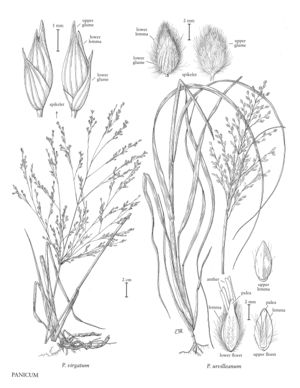Difference between revisions of "Panicum urvilleanum"
FNA>Volume Importer |
imported>Volume Importer |
||
| (4 intermediate revisions by 2 users not shown) | |||
| Line 17: | Line 17: | ||
-->{{Treatment/Body | -->{{Treatment/Body | ||
|distribution=Calif.;Ariz. | |distribution=Calif.;Ariz. | ||
| − | |discussion=<p>Panicum urvilleanum grows on desert sand dunes and in creosote bush scrubland in the Mojave and Colorado desert regions of southern California, southern Nevada, and western Arizona. It also grows in Peru, Chile, and Argentina.</p> | + | |discussion=<p><i>Panicum urvilleanum</i> grows on desert sand dunes and in creosote bush scrubland in the Mojave and Colorado desert regions of southern California, southern <i>Nevada</i>, and western Arizona. It also grows in Peru, Chile, and Argentina.</p> |
|tables= | |tables= | ||
|references= | |references= | ||
| Line 26: | Line 26: | ||
-->{{#Taxon: | -->{{#Taxon: | ||
name=Panicum urvilleanum | name=Panicum urvilleanum | ||
| − | |||
|authority=Kunth | |authority=Kunth | ||
|rank=species | |rank=species | ||
| Line 33: | Line 32: | ||
|basionyms= | |basionyms= | ||
|family=Poaceae | |family=Poaceae | ||
| − | |illustrator=Linda A. Vorobik | + | |illustrator=Linda A. Vorobik;Cindy Roché |
| + | |illustration copyright=Utah State University | ||
|distribution=Calif.;Ariz. | |distribution=Calif.;Ariz. | ||
|reference=None | |reference=None | ||
| Line 39: | Line 39: | ||
|publication year= | |publication year= | ||
|special status= | |special status= | ||
| − | |source xml=https:// | + | |source xml=https://bitbucket.org/aafc-mbb/fna-data-curation/src/200273ad09963decb8fc72550212de541d86569d/coarse_grained_fna_xml/V25/V25_1268.xml |
|subfamily=Poaceae subfam. Panicoideae | |subfamily=Poaceae subfam. Panicoideae | ||
|tribe=Poaceae tribe Paniceae | |tribe=Poaceae tribe Paniceae | ||
Latest revision as of 18:56, 11 May 2021
Plants perennial. Culms 50-100 cm, erect, solitary or in small tufts from stout, scaly, creeping to vertical rhizomes or stolons, simple or branching at the base; nodes densely villous. Sheaths densely villous; ligules membra¬nous, ciliate, hairs 1.5-2 mm; blades 20-60 cm long, 4-10 mm wide, ascending to spreading, strigose to subglabrous, flat basally, tapering to a long, involute point. Panicles 20-30 cm long, 3-9 cm wide, narrow, shortly exserted; branches slender, ascending; secondary branches and pedicels 1-4 mm, crowded, ascending to appressed. Spikelets 5-7 mm, densely villous, hairs silvery or tawny-white. Lower glumes about 3/4 the length of the spikelets, 7-11-veined; upper glumes and lower lemmas 7-15-veined; lower florets staminate; lower paleas about as long as the lower lemmas; upper florets striate, margins of the upper lemmas villous, hairs white; lodicules very large. 2n = 36.
Discussion
Panicum urvilleanum grows on desert sand dunes and in creosote bush scrubland in the Mojave and Colorado desert regions of southern California, southern Nevada, and western Arizona. It also grows in Peru, Chile, and Argentina.
Selected References
None.
